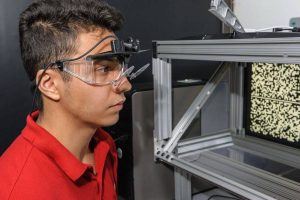Pencil push-ups are a commonly prescribed eye exercise for the treatment of convergence insufficiency (CI).
The question is, are they really effective?
Pencil push-up treatment (PPT) is generally prescribed in an attempt to teach the brain to work more efficiently for improved binocular vision.
Pencil push-ups are typically performed with a pencil, though any object similar to the shape of a pencil can be used as well. The pencil or other object that is used contains letters or shapes for the patient to focus on throughout the exercise.
During this exercise, the patient slowly moves the pencil toward their nose and then away from their nose, while keeping their eyes on the target letters at all times.
The goal of PPT is to maintain single and clear vision for the duration of the exercise.
The question is, how effective is PPT?
Research on the efficacy of PPT
Studies have compared the efficacy of PPT to in-office vision therapy for the treatment of CI.
One important study called the Convergence Insufficiency Treatment Trial (CITT) measured children’s CI scores before and after various 12 week treatment programs.
The scores were based on the Convergence Insufficiency Symptom Survey, which states that a score of 16 or higher is considered significant when diagnosing CI.
According to the research findings:
- After 12 weeks of PPT: CI scores only decreased from 29.3 to 25.9.
- After 12 weeks of in-office vision therapy: CI scores decreased significantly from 32.1 to 9.5.
Conclusion: A score of 9.5 post vision therapy compared to a score of 25.9 post PPT, shows that in-office vision therapy provided a superior result, when compared to pencil push up exercises.
Another study that compared the efficacy of in-office vision therapy to PPT, included adults ages 19 to 30.
- After 12 weeks of in-office vision therapy: 58% of the patients were considered “cured”, and if they would continue with vision therapy, their results would continue to improve.
- After 12 weeks of PPT: Only 20% of the patients were considered “cured” as 80% of the patients continued to display CI symptoms— and if they would continue with PPT, there would be no significant decrease in their symptoms.
Conclusion: Similar to the study that included children, this study also revealed that pencil push-ups are not an effective treatment for CI.
Contact an eye doctor near you to find out more about how PPT can help with vision.
SEE RELATED: Convergence Insufficiency FAQs
Are PPT exercises effective in combination with vision therapy?
According to the Convergence Insufficiency Treatment Trial, office-based vision therapy with home reinforcement exercises is the most effective treatment for CI.
Although studies show that PPT is not an effective treatment for CI when prescribed alone, some optometrists may still use PPT as part of a vision therapy program, along with other eye exercises aimed at improving binocular vision.
However, it is important to understand that while pencil push-ups may be prescribed during a vision therapy program, they will not carry a heavy weight toward the treatment goal of improved convergence and binocular vision.
A comprehensive vision therapy program includes many different eye exercises aimed to strengthen convergence skills, and pencil push-ups alone cannot treat the convergence insufficiency problem.
LEARN MORE: Vision Therapy for Children
If you are experiencing headaches or eye strain while reading, knitting, working on the computer, or performing any other near vision task, schedule an appointment for a comprehensive vision evaluation with an optometrist.
Your optometrist can assess your convergence skills and determine if a program of vision therapy can help you.
Vision therapy is the most effective treatment method for convergence insufficiency, as it helps to retrain your visual skills— for clear and comfortable vision while you perform the activities you enjoy most.










